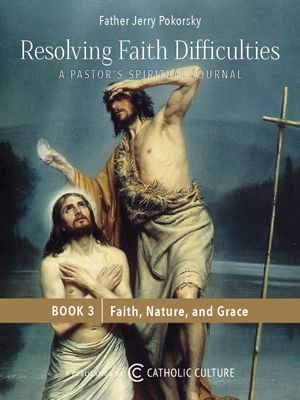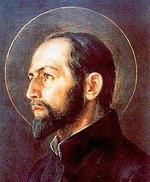Rebuilding Catholic Culture: a new gem of apologetics
By Phil Lawler ( bio - articles - email ) | Apr 08, 2013 | In Reviews
“A vibrant Catholic culture makes intelligible a mode of life and the habits of being that fit us for Heaven,” writes Ryan N. S. Topping in Rebuilding Catholic Culture. The reverse, unfortunately, is also true. In the absence of a distinctive Catholic culture, the path toward sanctity is no longer intelligible to most people, and countless souls go astray.
In this delightful little gem from Sophia Press, Topping begins with the truth that every culture is formed by the society’s faith—the “cult” behind the culture—and proceeds to argue that the truths set forth in the Catechism of the Catholic Church form the basis for rebuilding a supportive culture in a society that has nearly lost all faith.
A culture, Topping explains, is not a collection of museum pieces; it is a way of life. Obviously one’s way of life will be ordered according to what one considers the most important things in life. For the ancient Greeks the worship of the gods informed not only the rituals of sacrifice, but also the works of philosophy, drama, music, and even athletic competition. So too for Christians the truths of the Gospel should penetrate every aspect of everyday existence: reinforcing virtues, setting priorities, helping build appreciation for the true, the good, and the beautiful.
Our Western civilization is unraveling, Topping writes, because the Christian faith that served as the basis for our common culture has been in a long retreat. Rebuilding the culture will require a revival of that faith. The author explains how the teachings of the Church should influence the lives of believers and shape the culture in which they live. Rebuilding Catholic Culture relies heavily on the Catechism, and even follows its organizational structure, examining first the contents of the faith, then the sacraments, then the moral life, and finally the practice of prayer.
If our culture is in a sad decline, Topping believes that the Church is in an excellent position to support a new culture, or rather a counter-culture. The confusions that followed the Second Vatican Council have been overcome, he writes; the continuity of Church teaching and the wisdom of ancient precepts have been reaffirmed, particularly by the last two pontificates. (Topping reminds his readers that Karl Rahner saw Vatican II as a decisive break in the Church’s approach, equaled in Church history only by the decision recorded in the Acts of the Apostles, allowing Gentiles into the young Christian community.) Catholics today should realize that their faith is the same as that of the Church that built Christendom, and the culture that flows from that faith should be, at least in essentials, the same as well.
Rebuilding Catholic Culture is a lively and readable work of apologetics. Topping combines a breadth of scope with an elegance of style, producing dozens of memorable insights and epigrammatic sentences. For example:
Unlike Protestant worship, Catholic liturgy never simply looks to the past. There is no lost golden age for the Church.
Or:
So in communism all are absorbed into the collective while in liberal capitalism the individual is isolated and left exposed; in both, humanity is under attack.
On one page (210) that richly deserves to be dog-eared, he follows this observation…
In an age in which enlightened opinion generally favors abortion, euthanasia, and the cloning of body parts, it turns out that believing in life after death supplies one of the sturdier defenses for the conviction that there should be life before death, too.
…with this one:
Christian hope is not to be confused with optimism. Optimism is the detritus left on the mud after the tide of Christian faith has retreated.
Topping is at his most persuasive when he outlines the ways in which the life of a Catholic family should be shaped by the faith, and how the patterns of Catholic family life should reinforce that faith. The reader comes to understand why he writes: “Every front-yard nativity scene is the fruit of eight hundred years of tradition.” It is surely a tradition worth preserving.
The one serious weakness of this otherwise excellent book is exposed when Topping reveals his practical strategy for building that sort of robust Catholic family life in a society that is at best apathetic, at worst hostile. He suggests: “Let us end abortion; have more children; teach them Latin; and build better churches.” Yes, but is that all? Serious Catholics have been battling for 40 years to end abortion, without success. Many of us have had large families and taught our children Latin, but our desire for more beautiful churches have been largely thwarted by Church officials still infected with the spirit of architectural modernism, and more likely to force the closing of parish churches than allow the construction of new ones.
Topping recognizes that the revival of a Catholic culture requires a dramatic commitment to living out the faith. But his proposed strategies do not supply the detailed blueprint that will be needed by young Catholics who will need guidance with the thousands of little everyday decisions that define one’s way of life. Which are the essential battles that must be fought? When is compromise possible and prudent? How far can one go, in accepting the benefits of life in the affluent Western world, without sacrificing one’s principles?
Of course one book cannot accomplish everything. Just as a nativity scene reflects 800 years of tradition, the everyday life of a healthy Catholic community—that is, a Catholic culture—reflects the influence of countless thinkers and shapers and makers and doers and mothers and fathers, all making their own contributions, all formed by their Catholic faith. With Rebuilding Catholic Culture, Topping has made his own noteworthy contribution, and left this reader looking for more.
All comments are moderated. To lighten our editing burden, only current donors are allowed to Sound Off. If you are a current donor, log in to see the comment form; otherwise please support our work, and Sound Off!








